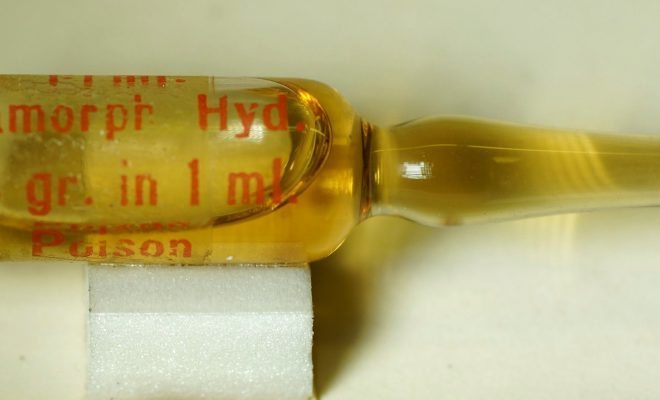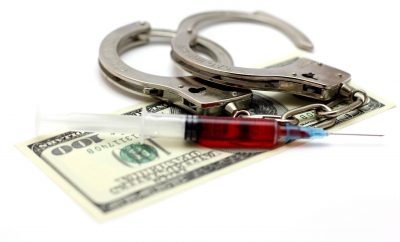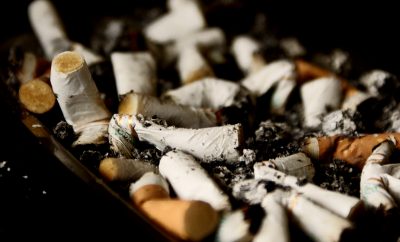 Image courtesy of [Sasha Taylor via Flickr]
Image courtesy of [Sasha Taylor via Flickr]
Health & Science
Heroin: The New Drug of the Middle Class?
Heroin addiction is a scary reality for many Americans. It’s often an ongoing roller coaster involving several rehab stints, withdrawal, and lifelong addiction struggles. And it’s unfortunately becoming a more common phenomenon. Today, the drug is no longer an outlier compared to its competitors. It has been identified by some as the new drug of the upper-middle class. Is this a fair assessment? Here are the facts.
What is heroin?
Heroin received its name from the “hero-like,” invincible effect the drug provides its user. It is also called by other names on the street including: H, Junk, Smack, Big H, Hell Dust, and countless others. Additives can change the color from white (pure heroin) to rose gray, brown, or black. Heroin can be laced with a variety of poisons and/or other drugs. It is injected, smoked, and snorted.
What is the science behind heroin?
From a scientific perspective:
Heroin is an opiate made from the chemical morphine, which is extracted from the dried latex of the opium poppy. Morphine is extracted from the opium latex, and these chemicals are used to make opiates, such as heroin, diamorphine and methadone. Heroin is the 3,6-diacetyl derivative of morphine (hence diacetylmorphine) and is synthesised from it by acetylation.
So what does that mean? Essentially, heroin is an opiate–a drug created from opium that sedates, tranquilizes, and/or depresses the body. It’s similar to a common base in a variety of pain killers–morphine. Opium comes from the cultivation of poppy seeds.
Effects of Heroin
Heroin users report several effects that differ based on the individual. Heroin can cause a temporary state of euphoria, safety, warmth, and sexual arousal. It can also create a sense of disconnect from other people, causing a dreamlike state and/or sense of floating. It is a depressant, rather than stimulant like cocaine, and it can be used as a self-medicated pain reliever.
Adversely, users can immediately experience vomiting, coughing, constipation, hypothermia, severe itching, and inability to orgasm. Long-term effects include rotten teeth, cold sweats, weakening of the immune system, respiratory illnesses, depression, loss of appetite, insomnia, and tuberculosis. Although this is not a direct effect, the sharing of needles from intravenous injection can often lead to AIDS, Hepatitis C, and other fatal infections.
After the effects wear off, users will start to feel extreme withdrawal symptoms if another dose is not administered. The symptoms of withdrawal can include “restlessness, aches and pains in the bones, diarrhea, vomiting, and severe discomfort.”
How do Americans get heroin?
Afghanistan is the “world’s largest exporter,” producing over 80 percent of the world’s opium. According to the United Nations Office on Drugs and Crime (UNODC), the Afghan poppy cultivation and opium industry amassed $3 billion in 2013, a 50 percent increase from 2012.
Overall, Mexico is the largest drug supplier to the United States. Specifically, Mexico produces Black Tar Heroin, one of the “most dangerous and addictive forms of heroin to date.” This variety looks more similar to hash than powder and can cause sclerosis and severe bacterial infections.
Colombia is the second largest Latin American supplier to the United States. Colombian cartels historically distribute from New York City and are in “full control of the heroin market in the Eastern United States.”
The “Golden Triangle” includes the countries of Burma, Vietnam, Laos, and Thailand. Before the escalation of the Afghan opium market, these southeastern Asian countries reigned over the world’s opium production.
Is it true that middle class heroin use is on the rise?
The Journal of the American Medical Association (JAMA) published a study in 2014 about the changing demographics of heroin users in the last 50 years. Over 2,800 people entering treatment programs participated in self-surveys and extensive interviews.
The results do seem to indicate that heroin is transitioning to the middle class. It is leaving the big cities and becoming more mainstream in the suburbs. Of course, there has been heroin drug use in suburbia before; however, now there is a marked increase.
In the 1960s, the average heroin user was a young man (average age of 16.5) living in a large urban area. Eighty percent of these men’s first experiences with an opioid was heroine. Today, the average heroin user is either a male or female in their twenties (average age of 23). Now, 75.2 percent of these users live in non-urban areas and 75 percent first experienced an opioid through prescription drugs. Almost 90 percent of first-time heroin users in the last ten years were white.
In New York City, doctors and drug counselors report a significant increase in professionals and college students with heroin addictions, while emergency rooms also report an increase in opiate overdoses. In Washington D.C., there has been a 55 percent increase in overdoses since 2010.
Why Heroin?
With all this information readily available through school systems and the internet, why is the educated, middle class turning to heroin? Factors may include increases in depression, exposure to painkillers, and acceptance. The perception of the heroin junkie has changed. A user can snort heroin (bypassing the track marks from injection) and go undetected by those around. It can be a clandestine affair–an appealing notion if the user does want to keep their drug use secret.
Anxiety disorders are the largest mental illness in the United States today, affecting more than 40 million Americans. In a country that loves to self-medicate, heroin offers a false yet accessible reprieve from anxiety and depression.
Prescription drug users also move to heroin. Prescription drugs are expensive and only legally last for the prescribed amount of time. To name a few, these gateway prescriptions drugs come in the forms of hydrocodone (Vicodin), fentanyl (Duragesic), and oxycodone (OxyContin). From 1999-2008, prescription narcotic sales increased 300 percent in the United States. Unlike these expensive prescriptions, a bag with approximately a quarter-sized amount of heroin can be sold for $10 off the streets. The transition isn’t hard to imagine, especially when the desired effects are similar.
Case Study: Understanding Suburban Heroin Use
Young upper-middle class adults are generally perceived as being granted every opportunity and foundation for success. Parents can afford a comfortable lifestyle and access to decent education for their children. So the question continues: why are so many from this walk of life turning to heroin? Through the funding of the Reed Hruby Heroin Prevention Project, the Illinois Consortium on Drug Policy conducted a report Understanding Suburban Heroin Use, to “demonstrate the nuanced nature of risk and protective factors among the heroin interviewees.” A risk factor puts a person in danger of using heroin, while a protective factor reduces the chance of use.
The overriding connection among the interviewees is the “experienced degree of detachment between parent and child and the overall lack of communication.” Contrary to common stereotypes, verbal, physical, and/or earlier drug abuse wasn’t vital in providing a pathway to heroin. A large portion of the answers, proved in these case studies, seem to be the previous emotional health of the users.
Example One
Interviewee one is a 31-year-old male who transitioned from pills to heroin. He is described as athletic, articulate, and candid. He was raised in an upper-middle class Chicago suburb. Although his family was close and intact, he experienced a sense of loneliness. His parents practiced a more hands-off approach to parenting that made him feel like an adult at an early age. His parents didn’t drink or abuse drugs during his childhood. His brother was diagnosed with ADHD, while he was not, although he experienced “restlessness.”
He was caught smoking marijuana at age 14 by his father, quit for a couple months, then resumed. His parents assumed he remained clean because he received good grades and they liked his group of friends. At age 17, he chose to work rather than attend college after graduating high school a semester early. He was earning almost as much income as his father. At 17, he tried his first opioid with a friend whose medical condition allowed easy access to OxyContin. When the prescription ran dry, they turned to heroine. He rationalized the transition thinking if he could handle OxyContin, he could handle heroin. Six months later, he was using approximately $100 worth of heroin daily and eventually moved to violent and illegal actions to sustain his supply. He admitted:
Heroin gave me something. It made me feel the best I have ever felt…Maybe I think love was missing. Like, love. I think. I that, uh, because I always felt like alone. Like even though I had good family, I always felt alone. Different.
Example Two
Interviewee two is a 27-year-old female from the western suburbs of Illinois. She is described as attractive, cheerful, and helpful. She was raised in an educated, wealthy family. She was a cheerleader in high school and earned good grades. There aren’t any psychological or substance abuse problems in her family. She felt disconnected from her siblings as they were much older and felt distant from her parents, as well. Her parents often “bickered” but never had big fights. When she confided in her mother as a child that she might be depressed, her mother seemingly brushed it off.
She started smoking pot in junior high at age 15. Although social, her group of friends was not part of the most popular crowd. This was a constant concern. She maintained a B average and continued with sports, while starting to smoke marijuana every day. An after-school job paid for this habit. When her parents found drug paraphernalia in her room, they didn’t probe the situation and just sent her to her room. Searching for a personal connection, she started dating an older boy. She connected with his parents in a way she could not with her own. During senior year, they both started using cocaine, which became a daily habit. She eventually transitioned to heroin, because as she put it in an answer to one question:
Heroin made me feel real mellow like I had not a care in the world. I had a lot of “what am I doing with my life” and physical pain that I was covering up.
After losing her job, she pawned her belongings with a variety of her parents’ things, and stole from others. She refrained from turning to prostitution, although she heard of other girls going down that road. She finally sought out help after witnessing her boyfriend get pistol-whipped and robbed during a drug exchange.
What does this tell us about heroin use?
There are similarities and differences to all of the case studies in this project. In these two examples, the users come from seemingly sturdy homes and backgrounds. The stereotypes of drug users aren’t present in these cases; however, they both felt distant from the people around them at an early age in life. They also wanted to avoid internal and external pressures. This glimpse into the lives of users offers some potential answers to the question of why relatively well educated, middleclass Americans may turn to heroin.
Fighting Back
In March 2014, the United States Department of Justice and the Attorney General Eric Holder vowed to take action against the “urgent public health crisis” of heroin and prescription opiates. Holder claimed that between 2006-2010, there was a 45 percent increase in heroin overdoses. To start, Holder pushed law enforcement agencies to carry the “overdose-reversal drug” Naloxone and urged the public to watch the educational documentary “The Opiate Effect.” Holder also outlined the DEA plan as follows:
Since 2011, DEA has opened more than 4,500 investigations related to heroin. They’re on track to open many more. And as a result of these aggressive enforcement efforts, the amount of heroin seized along America’s southwest border increased by more than 320 percent between 2008 and 2013…enforcement alone won’t solve the problem. That’s why we are enlisting a variety of partners – including doctors, educators, community leaders, and police officials – to increase our support for education, prevention, and treatment.
Conclusion
Heroin has seen a migration to the middle class. But what can we do to stop it? Many of these new users are already educated on the adverse effects of heroin and know the bottom line. A fear of health concerns isn’t enough. We need to stop it at the source, whether it is gateway prescription drugs or emotional health. Substance abuse is a disease to be cured, not the label of a criminal. The Affordable Care Act and Mental Health Parity and Addiction Equity Act aim to expand behavioral health coverage for 62.5 million people by 2020. Every addict, regardless of demographics, should have the ability and necessary tools to recover.
Resources
Primary
JAMA Psychiatry Releases: Demographics of Heroin Users Change in Past 50 Years
Reed Hruby Heroin Prevention Project: Understanding Suburban Heroin Use
Additional
About Health: What Heroin Effects Feel Like
Anxiety and Depression Association of America: Facts & Statistics
The New York Times: The Middle Class Rediscovers Heroin
Original Network of Resources on Heroin: Heroin By Area of Origin
RT: America’s $7.6 Billion War on Afghan Drugs Fails, Opium Production Peaks
Tech Times: Study Profiles New American Heroin Addicts
Foundation For a Drug Free World: The Truth about Heroin
WTOP: Heroin Use Rises in D.C. Among Middle, Upper Class








Comments